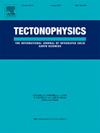北亚平宁山脉(意大利)暴露前沿的近期活动断层:实地考察和地质年代制约因素带来的新启示
IF 2.7
3区 地球科学
Q2 GEOCHEMISTRY & GEOPHYSICS
引用次数: 0
摘要
在活跃的浅层断层和深层震源之间建立遗传联系具有挑战性,尤其是在震源断层在地表缺乏清晰、易于解释的地质证据的地区。北亚平宁山脉(意大利)的佩德亚平宁山脉边缘的结构反映了一个区域规模的复杂东北向盲推系统,该系统被活跃的东北-西南造山运动压缩产生的换位/张性断层所分割。当地的地质框架由同生代的海洋衍生单元所定义,这些单元位于沿亚平宁半岛北部边缘及其东北部出露的上新世至今的岩层之上,而最内侧的岩层链部分则主要包含与亚得里亚海有关的单元。我们介绍了野外构造地质调查的结果,以确定和描述北亚平宁山脉边缘潜在的活动断层。在那里,上新世到现在的单元都有断层和褶皱,表明构造活动仍在继续,从而加剧了当地的地震灾害。该地区常见的是自上而下的 NE 和 SW 正断层,它们与 NE-SW 走向滑动断层和换位/张拉断层一起使上新世至今的岩层发生变形。根据实地证据,我们确定了四个潜在的活动推力段,这些推力段影响着沿边缘出露的中更新世至全新世沉积物。对断层样本进行的方解石 U-Th 测定将可追溯到中更新世的最新构造活动延伸到了中更新世。通过对最新发现的条状断层平面的断层滑动数据进行反演,古应力分析确定了与亚平宁山脉区域迁移方向平行的东北-西南缩短方向。同时还确定了一个独特但同轴的伸展应力机制,该机制由在上新世-更新世地层中测量到的结构记录下来。我们的研究结果为今后的研究提供了一个良好的起点,旨在提高我们对该地区活动断层和地震断层的认识,从而建立稳健的地震和断层位移危害概率评估(PSHA 和 PFDHA)模型,除了传统的地震学约束外,还能利用结构-地质确定性输入来绘制精细的地震危害图。本文章由计算机程序翻译,如有差异,请以英文原文为准。
Recent and active faulting along the exposed front of the Northern Apennines (Italy): New insights from field and geochronological constraints
Establishing genetic links between active shallow faulting and deep seismogenic sources is challenging, especially in areas where seismogenic faults lack clear and readily interpretable geological evidence at the surface. The architecture of the Pedeapenninic margin of the Northern Apennines (Italy) reflects a regional-scale and complex NE-verging blind thrust system, which is dissected by transpressive/transtensive faults resulting from active NE-SW orogenic compression. The local geological framework is defined by allochthonous ocean-derived units resting atop Pliocene-to-present successions exposed along the Northern Apennines margin and to the NE of it, while the innermost chain sector mostly contains Adria-related units. We present results from field structural-geological investigations to identify and characterize potential active faults along the margin. There, the Pliocene-to-present units are faulted and folded, indicating that tectonic activity is still on-going, thus contributing to the local seismic hazard. Top-to-the NE and SW normal faults are common in the area and deform the Pliocene-to-present succession together with NE-SW strike-slip and transpressional/transtensional faults. Based on field evidence, we define four potentially active thrust segments affecting Middle Pleistocene to Holocene deposits exposed along the margin. Calcite U-Th dating on samples from faults extend the most recent datable tectonic activity back to the Middle Pleistocene. Paleostress analysis from inversion of fault-slip data from the most recent identified striated fault planes constrains a NE-SW shortening direction parallel to the Apennines regional migration direction. A distinct but coaxial extensional stress regime, recorded by structures measured within Plio-Pleistocene formations, was also identified. Our results offer a sound starting point for future investigations aimed at improving our understanding of active and seismogenic faulting in the area, so as to create robust Probabilistic Seismic and Fault Displacement Hazard Assessment (PSHA and PFDHA) models that can implement refined seismic hazard maps benefitting from structural-geological deterministic inputs in addition to the classic seismological constraints.
求助全文
通过发布文献求助,成功后即可免费获取论文全文。
去求助
来源期刊

Tectonophysics
地学-地球化学与地球物理
CiteScore
4.90
自引率
6.90%
发文量
300
审稿时长
6 months
期刊介绍:
The prime focus of Tectonophysics will be high-impact original research and reviews in the fields of kinematics, structure, composition, and dynamics of the solid arth at all scales. Tectonophysics particularly encourages submission of papers based on the integration of a multitude of geophysical, geological, geochemical, geodynamic, and geotectonic methods
 求助内容:
求助内容: 应助结果提醒方式:
应助结果提醒方式:


